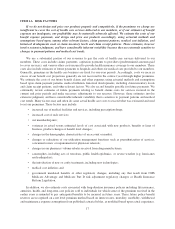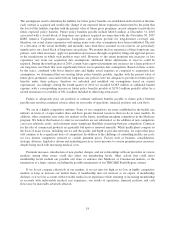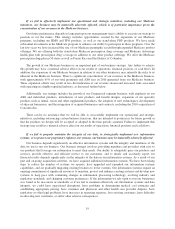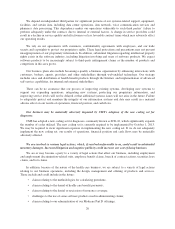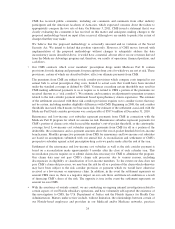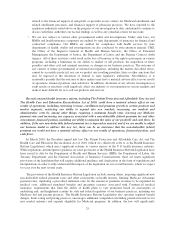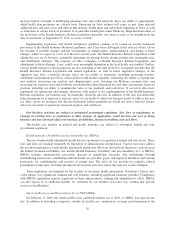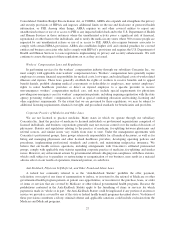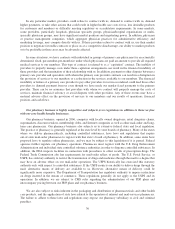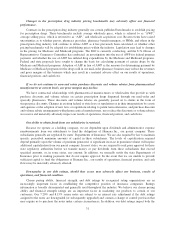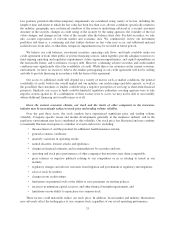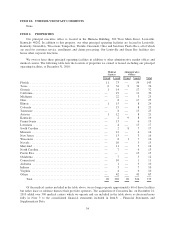Humana 2010 Annual Report Download - page 34
Download and view the complete annual report
Please find page 34 of the 2010 Humana annual report below. You can navigate through the pages in the report by either clicking on the pages listed below, or by using the keyword search tool below to find specific information within the annual report.CMS has received public comments, including our comments and comments from other industry
participants and the American Academy of Actuaries, which expressed concerns about the failure to
appropriately compare the two sets of data. On February 3, 2011, CMS issued a statement that it was
closely evaluating the comments it has received on this matter and anticipates making changes to the
proposed methodology based on input it has received, although we are unable to predict the extent of
changes that they may make.
We believe that the proposed methodology is actuarially unsound and in violation of the Social
Security Act. We intend to defend that position vigorously. However, if CMS moves forward with
implementation of the proposed methodology without changes to adequately address the data
inconsistency issues described above, it would have a material adverse effect on our revenues derived
from the Medicare Advantage program and, therefore, our results of operations, financial position, and
cash flows.
• Our CMS contracts which cover members’ prescription drugs under Medicare Part D contain
provisions for risk sharing and payments for prescription drug costs for which we are not at risk. These
provisions, certain of which are described below, affect our ultimate payments from CMS.
The premiums from CMS are subject to risk corridor provisions which compare costs targeted in our
annual bids to actual prescription drug costs, limited to actual costs that would have been incurred
under the standard coverage as defined by CMS. Variances exceeding certain thresholds may result in
CMS making additional payments to us or require us to refund to CMS a portion of the premiums we
received (known as a “risk corridor”). We estimate and recognize an adjustment to premium revenues
related to the risk corridor payment settlement based upon pharmacy claims experience. The estimate
of the settlement associated with these risk corridor provisions requires us to consider factors that may
not be certain, including member eligibility differences with CMS. Beginning in 2008, the risk corridor
thresholds increased which means we bear more risk. Our estimate of the settlement associated with the
Medicare Part D risk corridor provisions was a net payable of $387.6 million at December 31, 2010.
Reinsurance and low-income cost subsidies represent payments from CMS in connection with the
Medicare Part D program for which we assume no risk. Reinsurance subsidies represent payments for
CMS’s portion of claims costs which exceed the member’s out-of-pocket threshold, or the catastrophic
coverage level. Low-income cost subsidies represent payments from CMS for all or a portion of the
deductible, the coinsurance and co-payment amounts above the out-of-pocket threshold for low-income
beneficiaries. Monthly prospective payments from CMS for reinsurance and low-income cost subsidies
are based on assumptions submitted with our annual bid. A reconciliation and settlement of CMS’s
prospective subsidies against actual prescription drug costs we paid is made after the end of the year.
Settlement of the reinsurance and low-income cost subsidies as well as the risk corridor payment is
based on a reconciliation made approximately 9 months after the close of each calendar year. This
reconciliation process requires us to submit claims data necessary for CMS to administer the program.
Our claims data may not pass CMS’s claims edit processes due to various reasons, including
discrepancies in eligibility or classification of low-income members. To the extent our data does not
pass CMS’s claim edit processes, we may bear the risk for all or a portion of the claim which otherwise
may have been subject to the risk corridor provision or payment which we would have otherwise
received as a low-income or reinsurance claim. In addition, in the event the settlement represents an
amount CMS owes us, there is a negative impact on our cash flows and financial condition as a result
of financing CMS’s share of the risk. The opposite is true in the event the settlement represents an
amount we owe CMS.
• With the assistance of outside counsel, we are conducting an ongoing internal investigation related to
certain aspects of our Florida subsidiary operations, and have voluntarily self-reported the existence of
this investigation to CMS, the U.S. Department of Justice and the Florida Agency for Health Care
Administration. Matters under review include, without limitation, the relationships between certain of
our Florida-based employees and providers in our Medicaid and/or Medicare networks, practices
24





